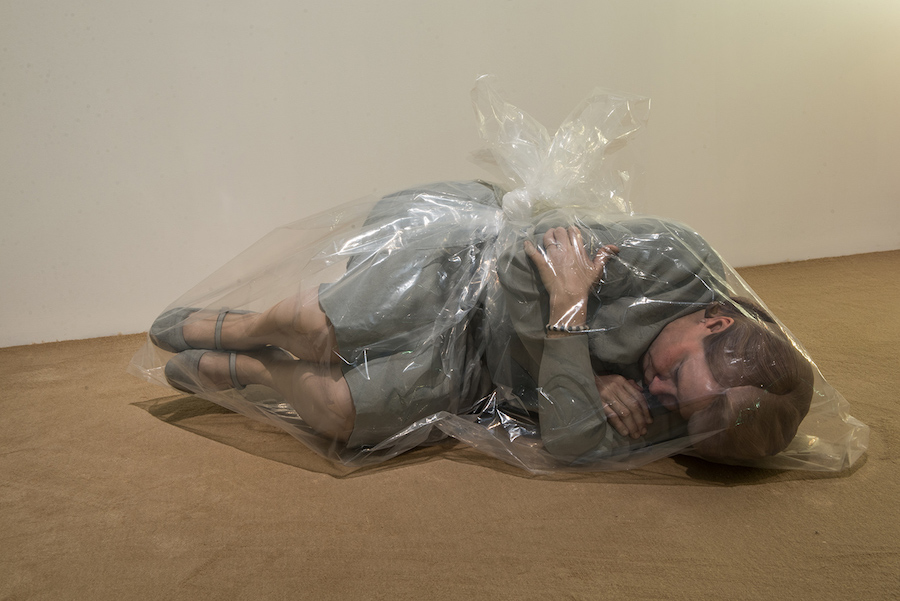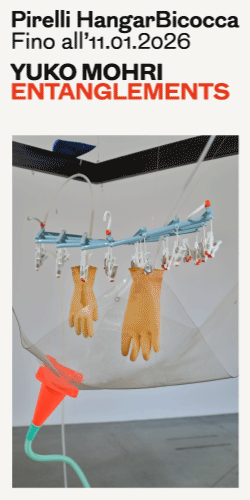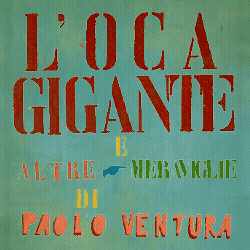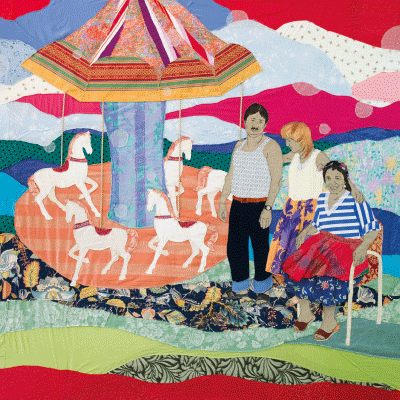
Segue il testo in italiano
Fondazione Sandretto Re Rebaudengo, on the occasion of Artissima, presents the first Italian solo show by Josh Kline (1979, Philadelphia), Unemployment. The exhibition, focused on the loss of job due to the augmented use of technology and the vision of humans as trash, proposes a vision of a conceivable horizon over the next 30 years, a dark and worried view on a future which features could be science-fictional but, unfortunately, really likely to be realised.
ATP: For your first Italian solo show at Fondazione Sandretto you proposed a very hot topic, particularly in Italy, that is unemployment and adjustment of job market, and of workers, to contemporary world. This is the second step of the project, which started in summer in New York. Did the structure of the exhibition change depending on the context?
Josh Kline: Unemployment isn’t a site-specific project. It is not about conditions unique to either New York City (where I live) or Turin. The project is about where all of the “advanced economies” seem to be heading in the not-so-distant future. Traveling from NYC to Turin, the show’s architecture will change. In New York, our apartments and our spaces for exhibiting art are generally small. In Turin, at FSRR, I’m working with a larger space and am able to show Unemployment at the scale I originally imagined. The architecture of the space will also be a closer match for my original ideas. There are a number of new works—which complete the suite of sculptures that are the core of the project—which will be shown for the first time in Turin.
ATP: Why did you decide to deal with this theme?
JK: Unemployment is the second chapter in a larger cycle of projects about the politics and economics of the 21st Century. Each installment will explore a different key issue or set of issues that seem likely to define the coming decades. It’s a look ahead at where our societies might be going—at possible futures. The first project Freedom (2015) was set in the aftermath of the 2008 financial crisis and dealt with the possibilities of political change and political speech in a world where the social commons has been privatized. A world of voluntary surveillance. Unemployment jumps ahead a generation and looks at technological unemployment and the end of the middle class in the West – a time in the near future when jobs like accountant, secretary, paralegal, administrator, etc. are replaced by software.
The populist right-wing movements in Europe and the United States—driven by the evisceration of Western blue-collar jobs and the automation or offshoring of manufacturing—can be seen as a harbinger of what is to come. After coming for the factory workers—and soon the taxi and truck drivers—software and automation are set to march on many of the jobs that support the middle-class. We are told that there will be plentiful “good jobs” on the other side of all this intelligent software, but I think that’s not realistic. The news tells us constantly that the people voting for Brexit and Trump live in the formerly industrial regions of these countries—the rust belts. People replaced by robots or cheaper labor offshore. What happens if and when the middle-class follows them into professional oblivion?
ATP: The phenomena you analyze through the works exhibited in this show (technology that starts to control human life, dehumanization of work, the conflict among life, work and economy) are topics that make me think immediately of George Orwell’s 1984, besides real life. Your reflection is more centered on daily life than on science-fiction imagination, right?
JK: My art is about the human condition in the 21st Century, in our time and in the years to come. Unemployment is science fiction. It’s loosely set in the 2030s—fifteen to twenty-five years from our present. The science fiction stories we see at the movies are usually about hero celebrities in spaceships saving space capitalism. There’s no rule, though, that says science fiction can’t be about daily life. What do the lives of ordinary people look like in the future? What can they look like?
I think it’s as important to plan for the future as it is to look back at and learn from history. Anticipating the future is something our political systems do a poor job at, and yet the future’s building blocks are all around us. The future doesn’t appear out of thin air. We’re all building it right now. In the West, our politics have a hard time grappling with anything beyond the next election cycle, much less the next decade. Since many of us will spend decades—the rest of our lives—living in the future, we should think hard about technological, economic, and environmental change will shape it.
ATP: You use very mixed media, among others also the technology you criticize in some ways. Why?
I am critical of some ways in which technology is being used, but I’m also in awe of the possibilities it presents for human liberation. The issue is how technology is used and what ideologies shape those uses. As an artist, I use whatever media will get the message across. I see part of my role being to choose the right tool for the job and part of that job is communicating with audiences who don’t have a background in art. Only a few people study art history, but almost everyone watches TV shows and looks at ads.
ATP: The scenario of your work is really dystopic, but also ironic. How do you make these aspects live together?
There’s nothing ironic in the exhibition in Turin (for me). It’s not a joke. In the past much of my work relied on a dark humor, but I’ve stripped away the comedy for this project. Unemployment is tragedy.
ATP: Advertisement (which always presents an ideal and rosy idea of the future) and harmony with real life do not coexist easily. In your work you contrast these aspects to highlight their problems or do you prefer to let them mix so that the distance between them becomes more visible, as it is the case in reality?
Advertisements don’t always present an ideal and rosy vision of the future. In the United States we have drowned in dark and depressing political ads during this presidential campaign. The commercials for Trump and Clinton depict all manner of devastation and apocalypse depending on the outcome of our elections.
The distinction between advertising and communicating has blurred for people who use smart phones and computers. I don’t think there’s much distance between “real life” and advertising any more. Hundreds of millions if not billions of people across the planet use social media to advertise themselves, their friends and family, their careers, and their leisure activities. The social media companies make their fortunes by turning our lives into entertainment and selling advertising around it. In my work, I want to see what other stories can be told using these tools.

Intervista con Josh Kline – Fondazione Sandretto Re Rebaudengo, Torino
La Fondazione Sandretto Re Rebaudengo, in occasione di Artissima, presenta la prima mostra personale dell’artista americano Josh Kline (1979, Philadelphia), Unemployment. La mostra, incentrata sul tema della perdita del lavoro a causa della tecnologizzazione delle attività e della visione dell’essere umano come un rifiuto, propone una visione dell’orizzonte ipotizzabile per i prossimi 30 anni, uno sguardo cupo e preoccupato su un futuro dalle sembianze fantascientifiche ma, purtroppo, molto verosimili.
ATP: Per la tua prima mostra personale italiana alla Fondazione Sandretto proponi un tema molto attuale, specialmente in Italia, quello della disoccupazione e dell’adattamento del mercato del lavoro, e dei lavoratori, al mondo contemporaneo. Questa è la seconda tappa del lavoro, partita in estate da New York. La struttura della mostra è cambiata in base al contesto?
JK: Unemployment non è un progetto site-specific. Non parla di condizioni che si presentano come uniche a New York (dove vivo) o a Torino. Il progetto riflette sulla direzione presa dalle cosiddette “economie avanzate” per il prossimo futuro. Ma viaggiando da New York a Torino la mostra cambierà. A New York generalmente gli spazi espositivi e di vita sono piccoli. A Torino, alla Fondazione Sandretto Re Rebaudengo, lavoro su una scala molto più ampia e sono così in grado di mostrare Unemployment alla scala in cui l’avevo immaginata. L’architettura dello spazio sarà anche molto più vicina all’idea della mostra che mi ero fatto in origine. Ci sono alcuni lavori – che completano la serie di sculture cuore del progetto – che saranno esposte per la prima volta proprio a Torino.
ATP: Come mai hai deciso di analizzare questo tema?
JK: Unemployment è il secondo capitolo di un ciclo di progetti sulla politica e l’economia del XXI secolo. Ogni installazione esplorerà un diverso tema centrale o gruppo di temi che sembrano in grado di definire l’andamento dei prossimi decenni. E’ uno sguardo sul futuro delle nostre società, quale direzione prenderanno – uno sguardo su futuri possibili. Il primo progetto Freedom (2015) era ambientato nel periodo immediatamente successivo alla crisi finanziaria del 2008 e si focalizzava sulle possibilità di cambiamento politico e discorso politico in un mondo dove I beni comuni sono stati privatizzati. Un mondo di sorveglianza volontaria. Unemployment salta una generazione e si concentra sulla disoccupazione tecnologica e la fine della classe media occidentale – un momento nel prossimo futuro in cui mestieri come il contabile, la segretaria, l’avvocato, l’assistente, l’amministratore ecc., saranno rimpiazzati dai computer.
I movimenti populisti di destra in Europa e negli Stati Uniti – guidati dalla “macellazione” delle tute blu e dall’automazione e delocalizzazione della manifattura – possono essere vista come un’avvisaglia di ciò che verrà. Dopo essere stati pensati per gli operai – e presto per autisti di taxi e camion – software specifici e automazione sono programmati per continuare a marciare sui lavori tipici della classe media. Ci viene continuamente ripetuto che ci saranno migliaia di “ottimi posti di lavoro” connessi a questi software intelligenti, ma io non credo sia realistico. I telegiornali ci dicono continuamente che le persone che hanno votato per la Brexit e voteranno per Trump vivono nelle ex regioni industriali di questi paesi – le cosiddette “cinture di ruggine”. Le persone sono sostituite da robot o lavoro più economico in paesi in via di sviluppo. Cosa succederà se e quando la classe media seguirà queste persone nel proprio oblio professionale?
ATP: Molti fenomeni che presenti attraverso il tuo lavoro esposto in questa mostra (la tecnologia che prende il controllo della vita umana, la disumanizzazione del lavoro, il conflitto tra vita, lavoro ed economia) sono temi che mi fanno pensare immediatamente a 1984 di George Orwell, oltre che alla vita reale. La tua è una riflessione sul reale piuttosto che sull’immaginario della fantascienza, giusto?
JK: La mia arte si occupa della condizione umana del XXI secolo, nel nostro tempo e negli anni a venire. Unemployment è fantascienza. É ambientato negli anni 2030 – tra i quindici e i venticinque anni di distanza da ora. Le storie di fantascienza che vediamo nei film trattano normalmente di eroi e personaggi importanti dentro astronavi che si battono per salvare il capitalismo spaziale. Non c’è una regola, comunque, che dice che la fantascienza non deve parlare della vita quotidiana. Come saranno le vite quotidiane delle persone nel futuro? Che aspetto potrebbero avere?
Penso che pianificare il futuro sia importante tanto quanto imparare dal passato. Anticipare il futuro è qualcosa che il nostro sistema politico si è dimostrato non in grado di fare, mentre le residenze del futuro sono già attorno a noi. Il futuro non nasce dal niente. Lo stiamo tutti costruendo minuto per minuto. In Occidente la politica ha difficoltà con qualsiasi cosa che superi temporalmente la successiva tornata elettorale, figuriamo I prossimi decenni. Dato che molti di noi spenderanno I propri decenni futuri – il resto delle nostre vite – vivendo nel futuro, dovremmo pensare bene a come cambiamenti tecnologici, economici e ambientali gli daranno una determinata forma.
ATP: Usi tecniche decisamente miste, tra cui anche molta della tecnologia che in qualche modo critichi. Da dove viene la tua scelta?
Sono abbastanza critico su alcuni modi in cui la tecnologia viene usata, ma resto anche sbalordito dalle possibilità che presenta per la liberazione umana. Il punto è come la tecnologia è utilizzata e quali ideologie modellano questi usi. Come artista uso qualsiasi mezzo con cui riesco a far passare il mio messaggio. Vedo parte del mio ruolo nel decidere il mezzo giusto per il lavoro e parte del lavoro è comunicare con un pubblico che non ha un background artistico. Solo poche persone studiano storia dell’arte, ma quasi tutti guardano show televisivi e vedono la pubblicità.
ATP: Lo scenario del tuo lavoro è decisamente distopico, ma anche ironico. Come coniughi questi due aspetti?
JK: Trovo non ci sia niente di ironico nella mostra di Torino. Non è uno scherzo. In passato molto del mio lavoro era basato sullo humor nero, ma ho tolto questo aspetto di commedia dal mio progetto. Unemployment è una tragedia.
ATP: La pubblicità (che presenta un’immagine ideale e sempre rosea del futuro) e l’aderenza al reale convivono in modo difficile. Nel tuo lavoro li contrapponi per evidenziarne i bachi o lasci che si fondano per sottolineare ancor meglio la loro distanza, così come succede nella realtà?
JK: Le pubblicità non presentano sempre una visione rosea e ideale del futuro. Negli Stati Uniti siamo piombati in un clima di propaganda politica cupa e depressiva durante questa campagna presidenziale. Le pubblicità per le campagne di Clinton e Trump dipingono ogni tipo di devastazione e apocalisse a seconda dei risultati delle elezioni.
La distinzione tra pubblicità e comunicazione si è rarefatta per le persone che usano smartphones e computers. Non credo ci sia più molta distanza oggi tra la “vita vera” e la pubblicità. Centinaia di migliaia se non milioni di persone sul pianeta usano I social media per pubblicizzare se stessi, I propri amici e famiglie, le proprie carriere, le proprie attività nel tempo libero. Le aziende di social media fanno fortuna attraverso la trasformazione delle nostre vite in intrattenimento e vendendo pubblicità intorno a questo aspetto. Nel mio lavoro voglio proporre altre storie utilizzando questi mezzi.













